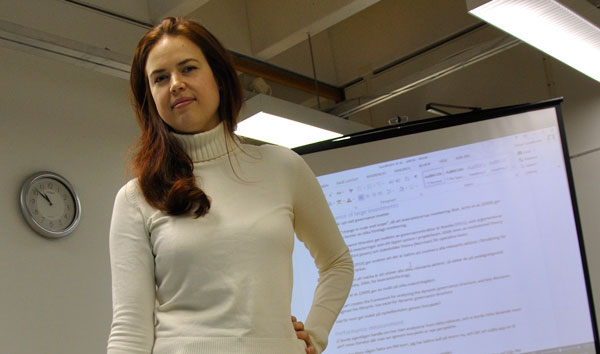Anastasia Tsvetkova. Photo: Marcus Prest.
The smooth running of a system in one location does not guarantee that it will work in another, despite the conditions being seemingly similar. The establishment of a sustainable industrial ecosystem requires a thorough understanding of all aspects of its life cycle in terms of production and consumption.
Marcus Prest
The successful establishment of a sustainable industrial ecosystem involves taking into consideration the financial, environmental and social aspects of each of its stages; not just those involved in production processes, but also in the consumption of the products. In addition, potential by-products are recycled at all stages of both production and consumption. In her doctoral thesis in industrial management at Åbo Akademi University, Anastasia Tsvetkova has concretised the model of an ecological ecosystem by using the production of biogas as a test example.
“Presently, the production of biofuels is organised according to the same model as the production of fossil fuels. This isn’t sustainable. Transporting biomass over long distances, as is done with oil, is not reasonable at any level at all,” Tsvetkova says.
The key difference between a traditional value chain and a sustainable industrial ecosystem is in the properties of their respective life cycles: in a sustainable industrial ecosystem the individual elements interact in both directions, while the direction in a traditional system is usually one-way only.
“In industrial ecosystems the activities should be organised in a way which is as sustainable as possible for the system as a whole. The flow of raw materials and products should be coordinated so that each participant involved in the system benefits from the others and the greatest quantity possible of the various products of the processes is efficiently utilised. This means that the main product finds its way to consumers and by-products can be re-introduced into the production life cycle.”
“Taking biogas as an example, this requires an understanding of the conditions for production and the conditions for consumption, such as the quantities that must be produced and sold in order for the process to be profitable. And one must also know the cost-structure so that, for example, a local public transport company is able to consider converting the fuel of their buses from diesel to biogas. The bus company needs to have certain information on the long-term price of gas and also have guarantees that gas will actually be available in the future.”
”A conversion to the use of biogas also requires the building of a new infrastructure comprising one or several filling stations for the buses, as well as a consideration of the logistics of delivering biogas from its producers to the filling stations. We should bear in mind that in order for an activity to be truly sustainable, it must also be profitable, not just environmentally and socially sustainable.”
“In a sustainable industrial ecosystem the various elements of the system are in optimal relation to each other internally. That is, they can depend on each other and carry a joint responsibility for the entire system. Sweden has successfully introduced this kind of ecosystem in local public transport.”
Why does a similar system not work in Finland?
“One aspect of the argument in my thesis is that a complex system which works in one place does not necessarily do so somewhere else.”
“The reason why biogas buses have not gained a foothold in Finland is due to cultural differences at a practical level. The environmental conditions are more or less the same; it’s cold for half of the year, and so on. Also the organisation of society is similar. But it seems that people in Sweden generally are less cautious and more willing to test and introduce new systems.”


